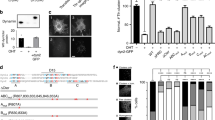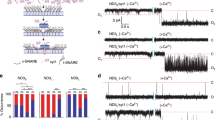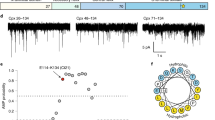Abstract
Amphiphysin, a protein that is highly concentrated in nerve terminals, has been proposed to function as a linker between the clathrin coat and dynamin in the endocytosis of synaptic vesicles. Here, using a cell-free system, we provide direct morphological evidence in support of this hypothesis. Unexpectedly, we also find that amphiphysin-1, like dynamin-1, can transform spherical liposomes into narrow tubules. Moreover, amphiphysin-1 assembles with dynamin-1 into ring-like structures around the tubules and enhances the liposome-fragmenting activity of dynamin-1 in the presence of GTP. These results show that amphiphysin binds lipid bilayers, indicate a potential function for amphiphysin in the changes in bilayer curvature that accompany vesicle budding, and imply a close functional partnership between amphiphysin and dynamin in endocytosis.
This is a preview of subscription content, access via your institution
Access options
Subscribe to this journal
Receive 12 print issues and online access
$209.00 per year
only $17.42 per issue
Buy this article
- Purchase on Springer Link
- Instant access to full article PDF
Prices may be subject to local taxes which are calculated during checkout







Similar content being viewed by others
References
Mundigl, O. et al. Amphiphysin I antisense oligonucleotides inhibit neurite outgrowth in cultured hippocampal neurons. J. Neurosci. 18, 93–103 (1998).
David, C., McPherson, P. S., Mundigl, O. & De Camilli, P. A role of amphiphysin in synaptic vesicle endocytosis suggested by its binding to dynamin in nerve terminals. Proc. Natl Acad. Sci. USA 93, 331–335 (1996).
Slepnev, V. I., Ochoa, G. C., Butler, M. H., Grabs, D. & Camilli, P.D. Role of phosphorylation in regulation of the assembly of endocytic coat complexes. Science 281, 821–824 (1998).
Wigge, P. & McMahon, H. T. The amphiphysin family of proteins and their role in endocytosis at the synapse. Trends Neurosci. 21, 339–344 (1998).
Cremona, O. & De Camilli, P. Synaptic vesicle endocytosis . Curr. Opin. Neurobiol. 7, 323– 330 (1997).
Butler, M. H. et al. Amphiphysin II (SH3P9; BIN1), a member of the amphiphysin/Rvs family, is concentrated in the cortical cytomatrix of axon initial segments and nodes of ranvier in brain and around T tubules in skeletal muscle. J. Cell Biol. 137, 1355–1367 (1997).
Leprince, C. et al. A new member of the amphiphysin family connecting endocytosis and signal transduction pathways. J. Biol. Chem. 272 , 15101–15105 (1997).
Ramjaun, A. R., Micheva, K. D., Bouchelet, I. & McPherson, P. S. Identification and characterization of a nerve terminal-enriched amphiphysin isoform. J. Biol. Chem. 272, 16700– 16706 (1997).
Wigge, P. et al. Amphiphysin heterodimers: potential role in clathrin-mediated endocytosis. Mol. Biol. Cell 8, 2003– 2015 (1997).
Wang, L. H., Südhof, T. C. & Anderson, R. G. W. The appendage domain of alpha-adaptin is a high affinity binding site for dynamin. J. Biol. Chem. 270, 10079– 10083 (1995).
McMahon, H. T., Wigge, P. & Smith, C. Clathrin interacts specifically with amphiphysin and is displaced by dynamin. FEBS Lett. 413, 319 –322 (1997).
Ramjaun, A. R. & McPherson, P. S. Multiple amphiphysin II splice variants display differential clathrin binding: identification of two distinct clathrin-binding sites. J. Neurochem. 70, 2369–2376 (1998).
McPherson, P. S. et al. A presynaptic inositol-5-phosphatase. Nature 379, 353–357 (1996).
Grabs, D. et al. The SH3 domain of amphiphysin binds the proline-rich domain of dynamin at a single site that defines a new SH3 binding consensus sequence . J. Biol. Chem. 272, 13419– 13425 (1997).
De Camilli, P. & Takei, K. Molecular mechanisms in synaptic vesicle endocytosis and recycling. Neuron 16, 481–486 (1996).
Urrutia, R., Henley, J. R., Cook, T. & McNiven, M. A. The dynamins: redundant or distinct functions for an expanding family of related GTPases? Proc. Natl Acad. Sci. USA 94, 377–384 (1997).
Shupliakov, O. et al. Synaptic vesicle endocytosis impaired by disruption of dynamin-SH3 domain interactions. Science 276, 259– 263 (1997).
Wigge, P., Vallis, Y. & McMahon, H. T. Inhibition of receptor-mediated endocytosis by the amphiphysin SH3 domain. Curr. Biol. 7, 554 –560 (1997).
Takei, K. et al. Generation of coated intermediates of clathrin-mediated endocytosis on protein-free liposomes. Cell 94, 131– 141 (1998).
Matsuoka, K. et al. COPII-coated vesicle formation reconstituted with purified coat proteins and chemically defined liposomes. Cell 93, 263–275 (1998).
Sweitzer, S. M. & Hinshaw, J. E. Dynamin undergoes a GTP-dependent conformational change causing vesiculation. Cell 93, 1021–1019 ( 1998).
Hao, W. et al. Regulation of AP-3 function by inositides. J. Biol. Chem . 272, 6393–6398 ( 1997).
Zhang, B. et al. Synaptic vesicle size and number are regulated by a clathrin adaptor protein required for endocytosis. Neuron 21 , 1465–1475 (1998).
David, C., Solimena, M. & De Camilli, P. Autoimmunity in Stiff-Man syndrome with breast cancer is targeted to the C-terminal region of human amphiphysin, a protein similar to the yeast proteins, Rvs167 and Rvs161. FEBS Lett. 351, 73–79 (1994).
Takei, K., McPherson, P. S., Schmid, S. L. & De Camilli, P. Tubular membrane invaginations coated by dynamin rings are induced by GTPγS in nerve terminals. Nature 374, 186– 190 (1995).
Bauerfeind, R., Takei, K. & De Camilli, P. Amphiphysin I is associated with coated endocytic intermediates and undergoes stimulation-dependent dephosphorylation in nerve terminals. J. Biol. Chem. 272, 30984–30992 (1997).
Hinshaw, J. E. & Schmid, S. L. Dynamin self-assembles into rings suggesting a mechanism for coated vesicle budding. Nature 374, 190–192 ( 1995).
Schmid, S. L. Clathrin-coated vesicle formation and protein sorting: an integrated process . Annu. Rev. Biochem. 66, 511– 548 (1997).
Gaidarov, I., Krupnick, J. G., Falck, J. R., Benovic, J. L. & Keen, J. H. Arrestin function in G protein-coupled receptor endocytosis requires phosphoinositide binding. EMBO J. 18, 871–881 ( 1999).
Oh, P., McIntosh, D. P. & Schnitzer, J. E. Dynamin at the neck of caveolae mediates their budding to form transport vesicles by GTP-driven fission from the plasma membrane of endothelium. J. Cell Biol. 141, 101– 114 (1998).
Henley, J., Krueger, E., Oswald, B. & McNiven, M. Dynamin-mediated internalization of caveolae. J. Cell Biol. 141, 85–99 (1998).
Polyakov, A., Severinova, E. & Darst, S. A. Three-dimensional structure of E. coli core RNA polymerase: promoter binding and elongation conformation of the enzyme. Cell 83, 365–373 ( 1995).
Wilson-Kubalek, E. M., Brown, R. E., Celia, H. & Milligan, R. A. Lipid nanotubes as substrates for helical crystallization of macromolecules. Proc. Natl Acad. Sci. USA 95, 8040–8045 (1998).
Carr, J. F. & Hinshaw, J. E. Dynamin assembles into spirals under physiological salt conditions upon the addition of GDP and gamma-phosphate analogues. J. Biol. Chem. 272, 28030– 28035 (1997).
Koenig, J. H. & Ikeda, K. Disappearance and reformation of synaptic vesicle membrane upon transmitter release observed under reversible blockage of membrane retrieval. J. Neurosci. 9, 3844 –3860 (1989).
Floyd, S. et al. Expression of amphiphysin I, an autoantigen of paraneoplastic neurological syndromes, in breast cancer. Mol. Med. 4, 29–39 (1998).
Slot, J. W. & Geuze, H. J. A new method of preparing gold probes for multiple-labeling cytochemistry. Eur. J. Cell Biol. 38, 87–93 ( 1985).
Reeves, J. P. & Dowben, R. M. Formation and properties of thin-walled phospholipid vesicles. J. Cell Physiol. 73, 49–60 (1969).
Campbell, C., Squicciarini, J., Shia, M., Pilch, P. F. & Fine, R. E. Identification of a protein kinase as an intrinsic component of rat liver coated vesicles. Biochemistry 23, 4420–4426 ( 1984).
Keen, J. H., Willingham, M. C. & Pastan, I. H. Clathrin-coated vesicles: isolation, dissociation and factor-dependent reassociation of clathrin baskets. Cell 16, 303–312 (1979).
Takei, K., Mundigl, O., Daniell, L. & De Camilli, P. The synaptic vesicle cycle: a single vesicle budding step involving clathrin and dynamin . J. Cell Biol. 133, 1237– 1250 (1996).
Liu, J. P., Zhang, Q. X., Baldwin, G. & Robinson, P. J. Calcium binds dynamin I and inhibits its GTPase activity. J. Neurochem. 66, 2074–2081 ( 1996).
Acknowledgements
This work was supported in part by grants from the NIH and the US Army Medical Research and Development Command (to P.D.C.), and a long-term fellowship from the Human Frontier Science Program (to V.H.).
Correspondence and requests for materials should be addressed to P.D.C.
Author information
Authors and Affiliations
Corresponding author
Rights and permissions
About this article
Cite this article
Takei, K., Slepnev, V., Haucke, V. et al. Functional partnership between amphiphysin and dynamin in clathrin-mediated endocytosis. Nat Cell Biol 1, 33–39 (1999). https://doi.org/10.1038/9004
Received:
Revised:
Accepted:
Issue Date:
DOI: https://doi.org/10.1038/9004
This article is cited by
-
Generation of nanoscopic membrane curvature for membrane trafficking
Nature Reviews Molecular Cell Biology (2023)
-
Insights into Membrane Curvature Sensing and Membrane Remodeling by Intrinsically Disordered Proteins and Protein Regions
The Journal of Membrane Biology (2022)
-
A Review of Mechanics-Based Mesoscopic Membrane Remodeling Methods: Capturing Both the Physics and the Chemical Diversity
The Journal of Membrane Biology (2022)
-
Dynamin-dependent vesicle twist at the final stage of clathrin-mediated endocytosis
Nature Cell Biology (2021)
-
Dynamic mechanochemical feedback between curved membranes and BAR protein self-organization
Nature Communications (2021)



